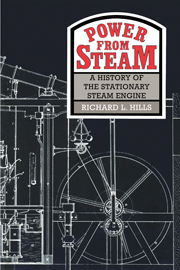Book contents
- Frontmatter
- Contents
- Preface
- Acknowledgements
- List of figures
- List of tables
- 1 The noblest machine
- 2 The impellent force of fire
- 3 Common old smoaking engines
- 4 The economy of power
- 5 The devil of rotations
- 6 Such unbounded power
- 7 Good servants but bad masters
- 8 An uncultivated field
- 9 The new theory of heat
- 10 The internal operation of the machine
- 11 Such absolute smoothness
- 12 Twinkle twinkle little arc
- 13 The drive for efficiency
- 14 An economical source of motive power
- 15 The most economical mode of obtaining power
- Notes
- Bibliography
- Index
7 - Good servants but bad masters
Boiler development (1700–1860)
Published online by Cambridge University Press: 01 June 2011
- Frontmatter
- Contents
- Preface
- Acknowledgements
- List of figures
- List of tables
- 1 The noblest machine
- 2 The impellent force of fire
- 3 Common old smoaking engines
- 4 The economy of power
- 5 The devil of rotations
- 6 Such unbounded power
- 7 Good servants but bad masters
- 8 An uncultivated field
- 9 The new theory of heat
- 10 The internal operation of the machine
- 11 Such absolute smoothness
- 12 Twinkle twinkle little arc
- 13 The drive for efficiency
- 14 An economical source of motive power
- 15 The most economical mode of obtaining power
- Notes
- Bibliography
- Index
Summary
The boiler is, in fact, to the steam engine what the living principle is to animated existence. Like the stomach, it requires food to maintain the temperature, circulation and constant action, which constitute the energy of the steam engine as motive power. To keep up the temperature we have to feed, stoke and replenish the furnace with fuel, and we may safely consider it a large digester, endowed with the functions of producing that supply of force required in the maintenance of the action of the steam engine.
So wrote Fairbairn in 1861. He had good reason to value the importance of boilers. He had built many steam engines and carried out experiments to improve their efficiency. He had also experimented with different types of boilers and tried various ways of burning coal in their furnaces as efficiently as possible, with the result that he developed the ‘Lancashire’ boiler, which was the most usual type in cotton mills from roughly the 1850s until the final abandonment of steam power.
Yet boilers have been too often the forgotten and most neglected parts of steam engines, with sometimes literally fatal results. This was because most people lacked even a basic understanding about how they should function. First, it was necessary to learn about the nature of coal and the different properties of the various types. Then the furnace had to be designed to burn the particular coal in the best way.
- Type
- Chapter
- Information
- Power from SteamA History of the Stationary Steam Engine, pp. 120 - 140Publisher: Cambridge University PressPrint publication year: 1989



